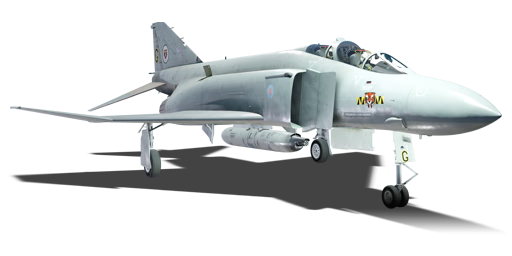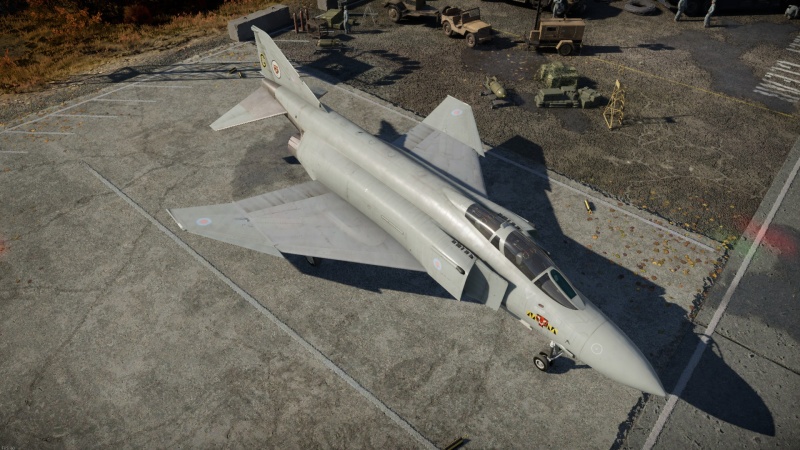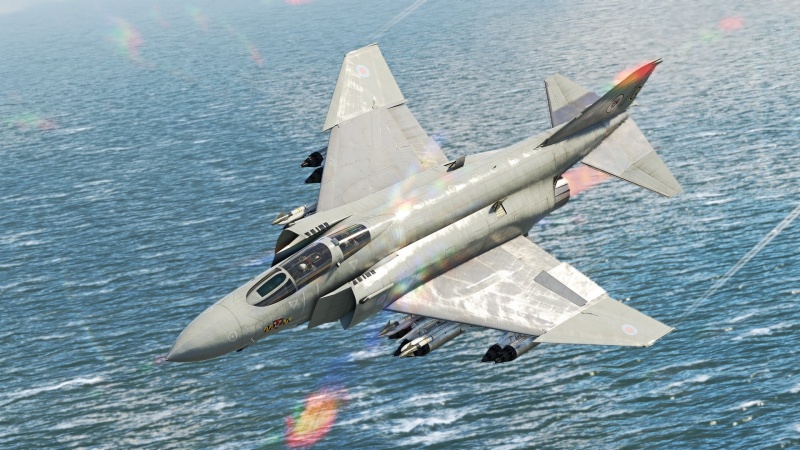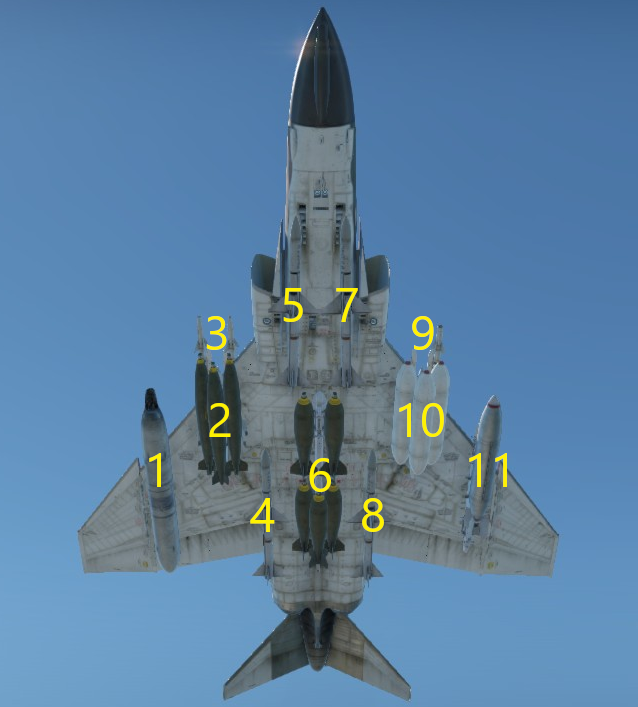F-4J(UK) Phantom II
| This page is about the premium British jet fighter F-4J(UK) Phantom II. For the American version, see F-4J Phantom II. For other versions, see F-4 Phantom II (Family). |
Contents
Description
The F-4J(UK) Phantom II is a premium gift rank VII British jet fighter with a battle rating of 11.0 (AB) and 11.3 (RB/SB). It was introduced in Update "Apex Predators".
General info
Flight performance
Describe how the aircraft behaves in the air. Speed, manoeuvrability, acceleration and allowable loads - these are the most important characteristics of the vehicle.
| Characteristics | Max speed (km/h at _,___ m) |
Max altitude (metres) |
Turn time (seconds) |
Rate of climb (metres/second) |
Take-off run (metres) | |||
|---|---|---|---|---|---|---|---|---|
| AB | RB | AB | RB | AB | RB | |||
| Stock | ___ | ___ | 16000 | __._ | __._ | __._ | __._ | ___ |
| Upgraded | ___ | ___ | __._ | __._ | __._ | __._ | ||
Details
| Features | |||||
|---|---|---|---|---|---|
| Combat flaps | Take-off flaps | Landing flaps | Air brakes | Arrestor gear | Drogue chute |
| ✓ | ✓ | ✓ | ✓ | ✓ | ✓ |
| Limits | ||||||
|---|---|---|---|---|---|---|
| Wings (km/h) | Gear (km/h) | Flaps (km/h) | Max Static G | |||
| Combat | Take-off | Landing | + | - | ||
| 1458 | 463 | 1,458 | 618 | 463 | ~11 | ~4 |
| Optimal velocities (km/h) | |||
|---|---|---|---|
| Ailerons | Rudder | Elevators | Radiator |
| < 810 | < 750 | < 700 | - |
Engine performance
| Engine | Aircraft mass | |||||
|---|---|---|---|---|---|---|
| Engine name | Number | Basic mass | Wing loading (full fuel) | |||
| General Electric J79-GE-10 | 2 | 14,205 kg | 408 kg/m2 | |||
| Engine characteristics | Mass with fuel (no weapons load) | Max Gross Weight | ||||
| Weight (each) | Type | 9m fuel | 20m fuel | 30m fuel | ||
| 1,750 kg | Afterburning axial-flow turbojet | 15,964 kg | 18,066 kg | 20,070 kg | 26,478 kg | |
| Maximum engine thrust @ 0 m (RB/SB) | Thrust to weight ratio @ 0 m (WEP) | |||||
| Condition | 100% | WEP | 9m fuel | 20m fuel | 30m fuel | MGW |
| Stationary | 5,250 kgf | 8,159 kgf | 1.02 | 0.90 | 0.81 | 0.61 |
| Optimal | 5,311 kgf (1,458 km/h) |
10,361 kgf (1,400 km/h) |
1.30 | 1.15 | 1.03 | 0.78 |
Survivability and armour
Examine the survivability of the aircraft. Note how vulnerable the structure is and how secure the pilot is, whether the fuel tanks are armoured, etc. Describe the armour, if there is any, and also mention the vulnerability of other critical aircraft systems.
Modifications and economy
Armaments
| Ballistic Computer | |||
|---|---|---|---|
| CCIP (Guns) | CCIP (Rockets) | CCIP (Bombs) | CCRP (Bombs) |
| |
|
|
|
Offensive armament
The F-4J(UK) Phantom II is armed with:
- A choice between two presets:
- Without offensive armament
- 60 x countermeasures
Suspended armament
The F-4J(UK) Phantom II can be outfitted with the following ordnance presets:
- 1 x 20 mm GAU-4 cannon (1,200 rpg)
- 4 x AIM-9G Sidewinder missiles
- 4 x AIM-7E Sparrow missiles
- 4 x Skyflash missiles
- 234 x SNEB type 23 rockets
- 11 x 1,000 lb H.E. M.C. Mk.13 bombs (11,000 lb total)
- 13 x 540 lb Mk.M2 bombs (7,020 lb total)
- 1 x 20 mm GAU-4 cannon + 4 x AIM-9G Sidewinder missiles + 4 x AIM-7E Sparrow missiles
- 1 x 20 mm GAU-4 cannon + 4 x AIM-9G Sidewinder missiles + 4 x Skyflash missiles
- 1 x 20 mm GAU-4 cannon + 4 x AIM-9G Sidewinder missiles + 4 x AIM-7E Sparrow missiles + 10 x 540 lb Mk.M2 bombs (5,400 lb total)
- 1 x 20 mm GAU-4 cannon + 4 x AIM-9G Sidewinder missiles + 4 x Skyflash missiles + 8 x 1,000 lb H.E. M.C. Mk.13 bombs (8,000 lb total)
- 1 x 20 mm GAU-4 cannon + 4 x AIM-9G Sidewinder missiles + 4 x Skyflash missiles + 180 x SNEB type 23 rockets
Custom loadout options
| 1 | 2 | 3 | 4 | 5 | 6 | 7 | 8 | 9 | 10 | 11 | ||
|---|---|---|---|---|---|---|---|---|---|---|---|---|
| 20 mm GAU-4 cannons (1,200 rpg) | 1 | |||||||||||
| 540 lb Mk.M2 bombs | 2 | 3 | 3 | 3 | 2 | |||||||
| 1,000 lb H.E. M.C. Mk.13 bombs | 2 | 2 | 3 | 2 | 2 | |||||||
| SNEB type 23 rockets | 36 | 54 | 54 | 54 | 36 | |||||||
| AIM-7E Sparrow missiles | 1 | 1 | 1 | 1 | ||||||||
| AIM-9G Sidewinder missiles | 2 | 2 | ||||||||||
| Skyflash missiles | 1 | 1 | 1 | 1 | ||||||||
| Maximum permissible weight imbalance: 1,500 kg | ||||||||||||
Usage in battles
The F-4J (UK) is a great aircraft but will feel out of place to new players. The main attraction to any Phantom is its missiles, however Skyflash missiles do not complement the F-4J(UK)'s gameplay. Being essentially an improved AIM-7E-2 Sparrow, the Skyflash does not have the long range performance of the AIM-7F Sparrow nor AIM-7M Sparrow (Skyflash with a 50 km launch range compared to AIM-7F's 100 km launch range). Not to mention you cannot roll out of the way of these high performance SARH missiles, forcing you to dump your lock and go 90° to attempt to force the missiles to overlead the other direction. In terms of raw G performance however, the Skyflash will absolutely pull all 25 Gs to hit a target (especially at short range) if you can maintain a radar lock. As a dogfight missile, the Skyflash starts pulling "off the rail", and will start pulling as soon as it clears the plane. Don't be afraid to fire at a non maneuvering target just within 2 kilometers (in a direct head on engagement).
As with all F-4s, sharp turns will quickly deplete your energy and speed. Made worse by the lack of a maneuvering speed, the F-4J(UK) will lose speed in nearly every turn at any speed. The F-4J(UK) is a heavy plane and will take an unacceptable (in terms of dodging missiles) amount of time to regain its speed in order to dodge another. Limit your time in open air and on the enemy's radar scopes if at all possible. Stay behind a teammate or behind the pack in general.
The AIM-9G Sidewinder is a good missile, but its relatively low G overload becomes a serious issue in dogfights. The AIM-9G will take a second to begin tracking and takes even longer to start pulling. A 3-4 km launch with a positive closure rate will usually be your best shot of hitting the target. The 18 G maximum overload is insufficient for anymore than a flat tail chase and the overload is only enough to allow the missile to maintain lock while leading a target. The AIM-9G will nearly always go for flares as there is nearly no flare resistance. Having a long burn time, the AIM-9G does have an exceptional range for an IR missile. The trade off is that it will burn nearly all the way to the target and have an exceptionally long boost/sustain phase, making the missile very easy to detect. Overall the AIM-9G is not a dogfight missile and will not fill in all the gaps left by the Skyflash.
The AN/APG-59 radar on the F-4J(UK) is a very average pulse-Doppler radar. Although you can theoretically get a radar lock on a target that is moving away from you at less that 540 km/h, the SARH missiles will have a difficult time getting a lock even if the radar is locked. Other than that the PD mode performs as you would expect, being especially potent in a head-on engagement.
If you are using this plane to grind out the UK tech tree, always bring at least 8 x 1,000 lb bombs. You will lose turn performance, however, your playstyle shouldn't change too much. the F-4J(UK) already is not competitive with other planes at this BR (in terms of turning performance) so when entering the merge, try and pick out a target you know has poor/no decent radar missiles. Other than that just take a few seconds to hit a base before turning back to reengage. Don't be afraid to Skyflash an enemy who is blocking your path to a base.
This combination of radar and missile leaves much to be desired and locks you into a less than optimal playstyle. The usual strategy is to go for head-on attacks to negate your lacklustre manoeuvrability and make the most out of your decent radar and missiles. But keep in mind you are almost always bringing a pistol to a long range sniper range. A competent opponent can easily roll out of the way of your missile and even then still might maintain a radar lock long enough to win the joust. The F-4J(UK) doesn't manoeuvre well enough to make a reliable last minute dodge so it is advisable to think ahead two steps when you anticipate a SARH joust. One thing you might want to get used to is pushing your nose down when dodging all aspect IR missiles. As your countermeasure pods fire directly upwards. The F-4J(UK) suffers from wing rip problems when pulling negative Gs so you will need to work out a techniques that works for you.
The best way to dodge long-mid range SARH shots and remain in position for the merge is to use hills and terrain features. The Phantom simply lacks the performance to pull multiple 90° turns and still be in a firing position for the merge. This is doubly important with any sort of bombload as you may find yourself struggling to notch within visual range distances (>20 km). If you miss the merge you will find yourself at the centre of a furball, attempting to outmanoeuvre significantly more agile and/or better-performing aircraft with much higher performance. Entering a fight at anything less than Mach 1 leaves you open to getting jumped by dedicated dogfighters without a clear way to escape.
Flying at treetop level will disrupt a radar lock by making the radar believe you are slightly lower than where you are (mistakes the ground below as part of the aircraft). This provides a safety from top-down attacks while still allowing you to maintain course for your own down-up SARH shots into the open sky.
Pros and cons
Pros:
- The F-4J(UK) does not lock up at high speed
- Sturdy airframe: hard to overspeed and hard to rip wings in positive G turns
- Effective air-to-air Skyflash missiles
- Can take 8 missiles without sacrificing bomb load
- Has access to a pulse doppler radar for "look-down, shoot-down" performance
- Heavy and effective bomb load for bombing either bases or ground targets
Cons:
- Doesn't turn very well, worse so with suspended weaponry like gunpods
- Wings rip easily in negative G manoeuvres
- Poor nose authority
- Skyflash missiles have relatively short range and can be kinetically dodged
- Skyflash missiles also have a tendency to not detonate or lose track at the last second
- AIM-9Gs fare poorly in dogfights and are easy to counter with flares
History
In 1984, following the deployment of a squadron of Phantoms to the Falkland Islands, the UK government decided that the gap this left in the UK air defences needed to be filled. They therefore sought to purchase another squadron of Phantoms, but as the ones already in RAF service were a special production batch it would not be possible to have the new ones be identical. It was decided that 15 Phantoms would be obtained from ex-USN F-4Js that were in storage. The F-4J was chosen as it was the closest to the current RAF Phantoms.
Following an extensive refurbishment at NAS North Island, where the Phantoms were brought to nearly F-4S standard (lacking leading-edge slats and a Helmet Gun Sight) the planes were delivered to the UK.
The major difference between the F-4J(UK) and the other UK operated Phantoms was the different engines, with the F-4J(UK) retaining the General Electric J79-10B turbojet, instead of the Rolls-Royce Spey turbofan. Upon initial delivery, the Skyflash AAM and SUU-23A gun pod were not compatible, however this was quickly rectified. Despite modifications to allow them to integrate with the other Phantoms, the F-4J(UK)s retained the vast bulk of their American equipment, even requiring the crews to use American helmets.
Although the new Phantoms were technically designated F.3, they were generally referred to as the F-4J(UK) to avoid confusion with the in service Tornado F.3.
Assigned to 74 Squadron at RAF Wattisham, they stood up in October 1984, 2 months after their first flight. Remaining in service through the transition to Tornado and the F-4M Squadrons being replaced with Tornados, the F-4J(UK) was retired in January 1991.
Media
- Skins
See also
Links to the articles on the War Thunder Wiki that you think will be useful for the reader, for example:
- reference to the series of the aircraft;
- links to approximate analogues of other nations and research trees.
External links
| McDonnell Aircraft Corporation | |
|---|---|
| Jet Fighters | F2H-2 · F3H-2 |
| F-4C Phantom II · F-4E Phantom II · F-4J Phantom II · F-4S Phantom II | |
| F-15A | |
| Export/Licensed | |
| Aircraft | ◄F-4F Early · ◄F-4F · Phantom FG.1 · Phantom FGR.2 · F-4J(UK) Phantom II · F-4EJ Phantom II · F-4EJ ADTW · Kurnass · Kurnass 2000 |
| Baz · F-15J | |
| ▄AV-8B Plus | |
| Helicopters | AH-6M · Lahatut |
| The McDonnell Aircraft Corporation merged with Douglas Aircraft Company in 1967 to form McDonnell Douglas. | |
| See Also | Mitsubishi Heavy Industries |
| Britain jet aircraft | |
|---|---|
| Blackburn | Buccaneer S.1 · Buccaneer S.2 · Buccaneer S.2B |
| British Aerospace | Harrier GR.7 · Sea Harrier FRS.1 (e) · Sea Harrier FRS.1 |
| British Aircraft Corporation | Strikemaster Mk.88 |
| English Electric | Canberra B Mk 2 · Canberra B (I) Mk 6 · Lightning F.6 · Lightning F.53 |
| Gloster | Meteor F Mk 3 · Sea Meteor F Mk 3 · Meteor F Mk 4 G.41F · Meteor F Mk 4 G.41G · Meteor F Mk 8 G.41K · Meteor F Mk.8 Reaper |
| Javelin F.(A.W.) Mk.9 | |
| de Havilland | Vampire F.B.5 · Venom FB.4 · Sea Venom FAW 20 · Sea Vixen F.A.W. Mk.2 |
| Hawker | Sea Hawk FGA.6 · Hunter F.1 · Hunter F.6 · Hunter FGA.9 · Harrier GR.1 · Harrier GR.3 |
| Panavia | Tornado GR.1 · Tornado F.3 |
| SEPECAT | Jaguar GR.1 · Jaguar GR.1A · Jaguar IS |
| Supermarine | Attacker FB 1 · Attacker FB.2 · Scimitar F Mk.1 · Swift F.1 · Swift F.7 |
| Foreign | Phantom FG.1 (USA) · Phantom FGR.2 (USA) · F-4J(UK) Phantom II (USA) |
| JAS39C (Sweden) | |
| Britain premium aircraft | |
|---|---|
| Fighters | Tuck's Gladiator Mk II · ▄Boomerang Mk I · ▄Boomerang Mk II · ▄D.520 |
| ▄Martlet Mk IV · ▄Corsair F Mk II · ▄Hellcat Mk II · ▄Thunderbolt Mk.1 · ▄Mustang Mk IA | |
| Hurricane Mk.I/L FAA M · Spitfire Mk.IIa Venture I · Spitfire F Mk IXc · Plagis' Spitfire LF Mk IXc · Spitfire F Mk XIVc · Prendergast's Spitfire FR Mk XIVe | |
| Typhoon Mk Ib · MB.5 | |
| Twin-engine fighters | Hornet Mk.I · Whirlwind P.9 |
| Jet fighters | Attacker FB.2 · Hunter FGA.9 · Lightning F.53 · Meteor F Mk.8 Reaper · Sea Vixen F.A.W. Mk.2 · F-4J(UK) Phantom II |
| Strike aircraft | ▄Wirraway · Beaufighter Mk I (40-mm) · Wyvern S4 |
| Harrier GR.1 · Strikemaster Mk.88 | |
| Bombers | ▄Avenger Mk II · ▄Boston Mk I · ▄Catalina Mk IIIa · ▄DB-7 · ▄Havoc Mk I · ▄Hudson Mk V · Swordfish Mk II |







